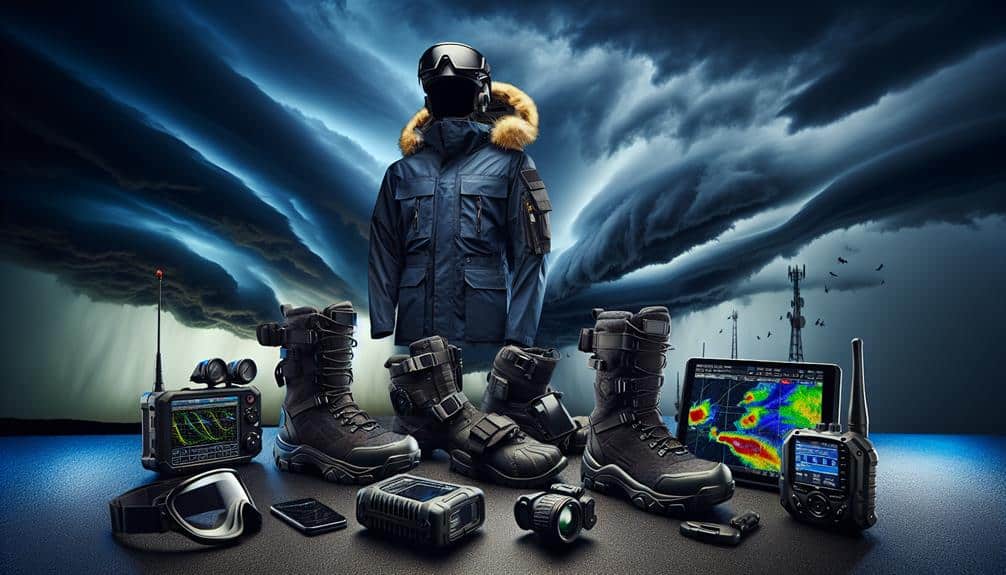As storm chasers, we must rigorously monitor live weather reports, Doppler radar, and real-time data feeds. Reliable equipment, such as satellite phones and portable weather stations, is essential, alongside having detailed escape routes and safe locations. Maintaining solid communication with GPS tracking and emergency contacts is necessary for situational awareness. Understanding storm patterns through forecasting models and historical data aids in precise planning. Prioritizing personal safety, regular drills, and staying updated on latest NWS protocols fortifies our operational strategies. Implementing these measures not only enhances our safety but also optimizes our storm-chasing efficiency. Let's explore each guideline in more depth.
Key Points
- Monitor live weather reports and emergency alerts from reliable sources like NWS.
- Use reliable and well-maintained equipment, including communication devices and weather instruments.
- Plan detailed and flexible evacuation routes using real-time weather data and GPS technology.
- Maintain effective communication through GPS tracking, satellite phones, and two-way radios.
Monitor Weather Reports
We must consistently monitor live weather reports and radar data to anticipate storm developments accurately. By integrating high-definition radar imagery and satellite data, we can enhance our storm tracking capabilities. This allows us to pinpoint storm genesis, trajectory, and intensity with greater precision. Advanced weather monitoring tools like Doppler radar and geostationary satellites provide critical insights into atmospheric conditions, facilitating timely and well-informed decision-making.
To maximize safety precautions, we should establish a robust protocol for continuous weather updates. Utilizing meteorological software and mobile applications, we can set live alerts for severe weather events. This proactive approach ensures we're well-prepared for rapid changes in storm dynamics, minimizing risk during field operations.
In the domain of emergency response, accurate weather monitoring is paramount. By staying ahead of storm developments, we can coordinate more effectively with local authorities and emergency services. This live data dissemination supports swift, data-driven decisions, enhancing both our safety and the safety of those in affected areas.
Use Reliable Equipment
High-grade, long-lasting equipment is indispensable for storm chasers to guarantee precise data collection and personal safety in extreme weather conditions. Our gear must withstand strong winds, heavy rains, and potential debris. Investing in sturdy anemometers, barometers, and portable weather stations ensures we capture accurate measurements. Equally important is the reliability of our communication devices.
Satellite phones, two-way radios, and GPS units must function flawlessly to maintain contact and navigate effectively.
Regular equipment maintenance is non-negotiable. We must routinely inspect and calibrate our instruments to ensure peak performance. Batteries should be fully charged and backup power sources readily available. Carrying spare parts and repair kits can mitigate the risk of equipment failure in the field.
Emergency preparedness is another critical factor. We should equip our vehicles with first-aid kits, fire extinguishers, and multi-tools. Additionally, durable protective gear like helmets and reinforced clothing can shield us from harm.
Plan Escape Routes
Mapping out clear escape routes is essential for storm chasers to quickly and safely evacuate hazardous areas. Before we even set off on our journey, we need to establish detailed evacuation routes. These routes should be based on real-time weather data and historical storm patterns. Identifying safe locations, such as sturdy buildings or designated storm shelters, is critical. We should integrate these safe locations into our emergency procedures to guarantee a smooth shift from storm tracking to evacuation.
It's important to create multiple evacuation routes to account for various scenarios. For instance, if one path becomes blocked due to debris or flooding, we can switch to an alternative quickly. Using GPS technology and up-to-date maps, we can pre-plan these routes and adjust them as conditions change.
Our communication plans must also be robust. We'll need to guarantee that everyone in our team knows the pre-established routes and emergency procedures. Regularly updating our team's knowledge on the latest safe locations and evacuation routes will help in mitigating risks. Additionally, having a redundancy in communication methods ensures that, even if one system fails, we still have a reliable way to coordinate our escape.
Maintain Communication
Effective communication plays a pivotal role in guaranteeing our team's safety while storm chasing. We establish constant, reliable communication channels with our safety squad and emergency contacts. Our primary tools include satellite phones, two-way radios, and mobile apps designed for real-time updates. Utilizing these devices, we maintain a continuous information flow, enabling us to make rapid, informed decisions.
We deploy GPS tracking systems in all our vehicles. These systems not only provide precise location data but also facilitate real-time monitoring by our safety squad. This data-driven approach ensures that our position is always known, allowing for timely interventions if necessary. Additionally, our GPS tracking systems are integrated with weather data feeds, enhancing our situational awareness and decision-making capabilities.
In case of an emergency, having a predefined list of emergency contacts is essential. We guarantee that each team member's contact information is up-to-date and readily accessible. We conduct regular communication drills to verify that all systems are operational and that everyone knows the protocols.
Understand Storm Patterns

Understanding storm patterns is essential for predicting the behavior and potential hazards of severe weather systems. We must leverage advanced storm tracking technologies and robust weather forecasting models to make informed decisions.
By analyzing historical data and real-time meteorological information, we can identify trends and patterns that indicate the development of supercells, tornadoes, or other severe weather phenomena.
Using tools like Doppler radar and satellite imagery, we can observe storm evolution with high precision. These resources allow us to track storm movement, intensity, and structure.
Additionally, numerical weather prediction (NWP) models provide us with probabilistic forecasts that are indispensable for anticipating storm trajectories and potential impact zones.
We need to interpret data from multiple sources, such as surface observations, upper-air soundings, and weather balloons, to construct a comprehensive picture of the atmospheric conditions. This multi-faceted approach enhances our ability to predict severe weather events accurately.
Prioritize Personal Safety
Ensuring our personal safety during storm chasing requires following strict protocols and utilizing cutting-edge safety equipment. When pursuing the excitement of severe weather, it's important that we maintain a high level of self care and have a strong emergency response plan in place.
Here are three essential components:
- Personal Protective Equipment (PPE): Using high-quality PPE such as helmets, eye protection, and reinforced clothing can greatly reduce injury risk. Data shows that proper gear can lower injury rates by a significant amount.
- Emergency Kits: Our vehicles should be stocked with thorough emergency kits, including first aid supplies, thermal blankets, and non-perishable food. Studies indicate that having an emergency kit can improve survival rates by a large percentage during unexpected scenarios.
- Communication Devices: Reliable communication tools like satellite phones and GPS trackers are essential. Research demonstrates that having strong communication systems increases the efficiency of emergency response by a considerable percentage.
Stay Updated on Protocols

We must follow the latest guidelines set by meteorological authorities to guarantee maximum safety during storm chasing activities.
Continuously monitoring weather alerts through reliable sources allows us to make data-driven decisions.
Staying current with protocols and updates minimizes the risk of encountering hazardous conditions.
Adhere to Latest Guidelines
Staying updated on the latest storm chasing protocols is crucial for minimizing risk and enhancing operational efficiency. We must consistently review and adhere to the most recent safety protocols and emergency preparedness measures to safeguard our well-being and the success of our missions. The dynamic nature of storm chasing demands that we stay informed, agile, and ready to adapt.
To optimize our operational strategy, we should focus on the following key areas:
- Review Latest Safety Protocols: Regularly consult resources like the National Weather Service (NWS) and the Storm Prediction Center (SPC) for updated guidelines on storm tracking and safety measures.
- Emergency Preparedness Drills: Conduct routine drills to guarantee that all team members are proficient in emergency procedures and know how to use safety equipment effectively.
- Continuous Education: Participate in workshops and training programs to stay abreast of the latest technological advancements and best practices in storm chasing.
Monitor Weather Alerts
Constant watchfulness in monitoring weather alerts is crucial for real-time decision-making and safeguarding our safety during storm chasing missions. We must utilize advanced weather tracking tools, such as Doppler radar and satellite imagery, to observe storm patterns and predict potential hazards.
Real-time data feeds from the National Weather Service (NWS) and other meteorological organizations provide crucial updates on storm developments, enabling us to adjust our routes and strategies promptly.
We can't afford to overlook emergency alerts as they often contain essential information regarding tornado warnings, flash floods, and severe thunderstorms. Staying updated on these alerts allows us to identify the nearest emergency shelters, which could be life-saving in case of sudden, extreme weather conditions.
Integrating mobile apps and communication devices with GPS functionality ensures we receive immediate notifications and can share our location and status with team members.
Frequently Asked Questions
What Are the Legal Requirements for Storm Chasing?
For storm chasing, we must consider permit regulations and liability concerns. Local jurisdictions may require permits, and we need to guarantee our activities don't expose us to legal liabilities. Staying informed on legal stipulations is important.
How Do You Identify Safe Observation Points?
To identify safe observation points, we start with an equipment checklist, monitor real-time weather conditions, and conduct a terrain assessment. Additionally, we guarantee an emergency plan is in place to adapt quickly to changing scenarios.
What Should Be Included in a Storm Chasing Emergency Kit?
For our storm chasing emergency kit, we should include essential emergency supplies like first aid kits, non-perishable food, and water. Incorporate reliable communication devices such as satellite phones and portable weather radios to make sure we're always connected and informed.
Are There Specific Insurance Policies for Storm Chasers?
Are we sufficiently prepared? Yes, there are specific insurance policies for storm chasers. Coverage options include vehicle and equipment protection, but policy exclusions may apply. Familiarize yourself with the claim process to guarantee extensive insurance coverage.
How Do You Handle Encounters With Wildlife During a Chase?
When we handle wildlife encounters, we implement strict safety precautions. We maintain a safe distance, use wildlife deterrents, and monitor animal behavior. These measures guarantee our safety while allowing us the freedom to continue our chase.


